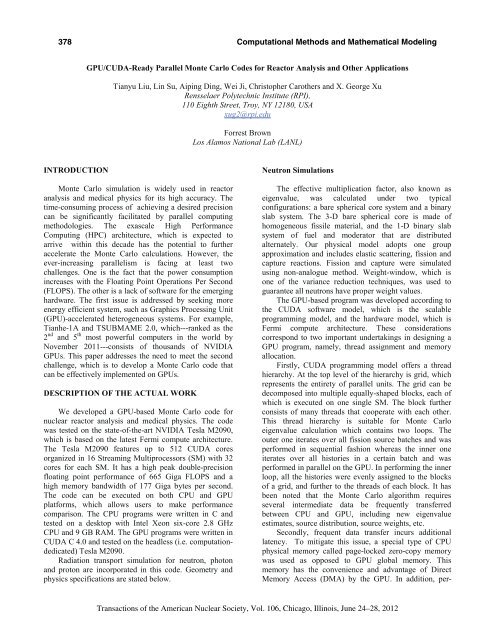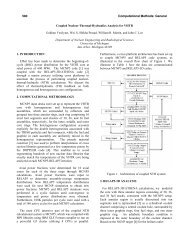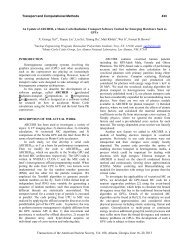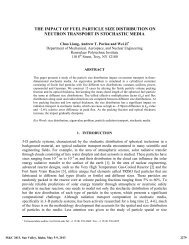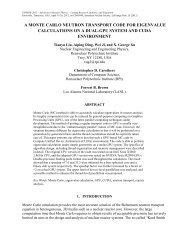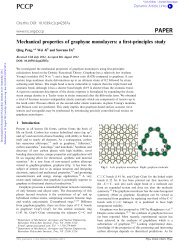GPU/CUDA-Ready Parallel Monte Carlo Codes for Reactor Analysis ...
GPU/CUDA-Ready Parallel Monte Carlo Codes for Reactor Analysis ...
GPU/CUDA-Ready Parallel Monte Carlo Codes for Reactor Analysis ...
You also want an ePaper? Increase the reach of your titles
YUMPU automatically turns print PDFs into web optimized ePapers that Google loves.
378 Computational Methods and Mathematical Modeling<br />
<strong>GPU</strong>/<strong>CUDA</strong>-<strong>Ready</strong> <strong>Parallel</strong> <strong>Monte</strong> <strong>Carlo</strong> <strong>Codes</strong> <strong>for</strong> <strong>Reactor</strong> <strong>Analysis</strong> and Other Applications<br />
Tianyu Liu, Lin Su, Aiping Ding, Wei Ji, Christopher Carothers and X. George Xu<br />
Rensselaer Polytechnic Institute (RPI),<br />
110 Eighth Street, Troy, NY 12180, USA<br />
xug2@rpi.edu<br />
Forrest Brown<br />
Los Alamos National Lab (LANL)<br />
INTRODUCTION<br />
<strong>Monte</strong> <strong>Carlo</strong> simulation is widely used in reactor<br />
analysis and medical physics <strong>for</strong> its high accuracy. The<br />
time-consuming process of achieving a desired precision<br />
can be significantly facilitated by parallel computing<br />
methodologies. The exascale High Per<strong>for</strong>mance<br />
Computing (HPC) architecture, which is expected to<br />
arrive within this decade has the potential to further<br />
accelerate the <strong>Monte</strong> <strong>Carlo</strong> calculations. However, the<br />
ever-increasing parallelism is facing at least two<br />
challenges. One is the fact that the power consumption<br />
increases with the Floating Point Operations Per Second<br />
(FLOPS). The other is a lack of software <strong>for</strong> the emerging<br />
hardware. The first issue is addressed by seeking more<br />
energy efficient system, such as Graphics Processing Unit<br />
(<strong>GPU</strong>)-accelerated heterogeneous systems. For example,<br />
Tianhe-1A and TSUBMAME 2.0, which---ranked as the<br />
2 nd and 5 th most powerful computers in the world by<br />
November 2011---consists of thousands of NVIDIA<br />
<strong>GPU</strong>s. This paper addresses the need to meet the second<br />
challenge, which is to develop a <strong>Monte</strong> <strong>Carlo</strong> code that<br />
can be effectively implemented on <strong>GPU</strong>s.<br />
DESCRIPTION OF THE ACTUAL WORK<br />
We developed a <strong>GPU</strong>-based <strong>Monte</strong> <strong>Carlo</strong> code <strong>for</strong><br />
nuclear reactor analysis and medical physics. The code<br />
was tested on the state-of-the-art NVIDIA Tesla M2090,<br />
which is based on the latest Fermi compute architecture.<br />
The Tesla M2090 features up to 512 <strong>CUDA</strong> cores<br />
organized in 16 Streaming Multiprocessors (SM) with 32<br />
cores <strong>for</strong> each SM. It has a high peak double-precision<br />
floating point per<strong>for</strong>mance of 665 Giga FLOPS and a<br />
high memory bandwidth of 177 Giga bytes per second.<br />
The code can be executed on both CPU and <strong>GPU</strong><br />
plat<strong>for</strong>ms, which allows users to make per<strong>for</strong>mance<br />
comparison. The CPU programs were written in C and<br />
tested on a desktop with Intel Xeon six-core 2.8 GHz<br />
CPU and 9 GB RAM. The <strong>GPU</strong> programs were written in<br />
<strong>CUDA</strong> C 4.0 and tested on the headless (i.e. computationdedicated)<br />
Tesla M2090.<br />
Radiation transport simulation <strong>for</strong> neutron, photon<br />
and proton are incorporated in this code. Geometry and<br />
physics specifications are stated below.<br />
Neutron Simulations<br />
The effective multiplication factor, also known as<br />
eigenvalue, was calculated under two typical<br />
configurations: a bare spherical core system and a binary<br />
slab system. The 3-D bare spherical core is made of<br />
homogeneous fissile material, and the 1-D binary slab<br />
system of fuel and moderator that are distributed<br />
alternately. Our physical model adopts one group<br />
approximation and includes elastic scattering, fission and<br />
capture reactions. Fission and capture were simulated<br />
using non-analogue method. Weight-window, which is<br />
one of the variance reduction techniques, was used to<br />
guarantee all neutrons have proper weight values.<br />
The <strong>GPU</strong>-based program was developed according to<br />
the <strong>CUDA</strong> software model, which is the scalable<br />
programming model, and the hardware model, which is<br />
Fermi compute architecture. These considerations<br />
correspond to two important undertakings in designing a<br />
<strong>GPU</strong> program, namely, thread assignment and memory<br />
allocation.<br />
Firstly, <strong>CUDA</strong> programming model offers a thread<br />
hierarchy. At the top level of the hierarchy is grid, which<br />
represents the entirety of parallel units. The grid can be<br />
decomposed into multiple equally-shaped blocks, each of<br />
which is executed on one single SM. The block further<br />
consists of many threads that cooperate with each other.<br />
This thread hierarchy is suitable <strong>for</strong> <strong>Monte</strong> <strong>Carlo</strong><br />
eigenvalue calculation which contains two loops. The<br />
outer one iterates over all fission source batches and was<br />
per<strong>for</strong>med in sequential fashion whereas the inner one<br />
iterates over all histories in a certain batch and was<br />
per<strong>for</strong>med in parallel on the <strong>GPU</strong>. In per<strong>for</strong>ming the inner<br />
loop, all the histories were evenly assigned to the blocks<br />
of a grid, and further to the threads of each block. It has<br />
been noted that the <strong>Monte</strong> <strong>Carlo</strong> algorithm requires<br />
several intermediate data be frequently transferred<br />
between CPU and <strong>GPU</strong>, including new eigenvalue<br />
estimates, source distribution, source weights, etc.<br />
Secondly, frequent data transfer incurs additional<br />
latency. To mitigate this issue, a special type of CPU<br />
physical memory called page-locked zero-copy memory<br />
was used as opposed to <strong>GPU</strong> global memory. This<br />
memory has the convenience and advantage of Direct<br />
Memory Access (DMA) by the <strong>GPU</strong>. In addition, per-<br />
Transactions of the American Nuclear Society, Vol. 106, Chicago, Illinois, June 24–28, 2012
Computational Methods and Mathematical Modeling<br />
thread local memory was used to store neutrons resulting<br />
from splitting technique whereby a neutron with large<br />
weight is decomposed into several neutrons with smaller<br />
weight. Besides, global memory was used to store a<br />
counter which indicates how many fission neutrons have<br />
been generated. Further, a combination of per-thread<br />
register, per-block shared memory and page-locked zerocopy<br />
memory were used to store temporary data <strong>for</strong><br />
eigenvalues calculation.<br />
Photon Simulations<br />
Two cases of special clinical importance were<br />
simulated. One is X-ray imaging simulation, and the other<br />
is associated radiation dose calculation. VIP-MAN, a<br />
voxelized computation human phantom was used to<br />
represent a patient receiving a routine X-ray chest<br />
screening. The phantom consists of 147×86×470 cubic<br />
voxels, each with a side of 4mm. A square parallel x-ray<br />
beam following a continuous spectrum with 120kVp was<br />
selected as the source and placed in front of the phantom.<br />
Three types of photo-atomic interactions were simulated:<br />
photoelectric effect, Compton scattering and Rayleigh<br />
scattering. The energy of the secondary electrons was<br />
assumed to be locally deposited. Kahn’s sampling<br />
technique was adopted to accelerate rejection sampling.<br />
The raw microscopic cross-section data were obtained<br />
from ENDF-VI, and all the macroscopic cross-sections,<br />
dependent upon energy and elemental composition were<br />
calculated on the spot.<br />
Thread assignment <strong>for</strong> <strong>GPU</strong> in case of photon is<br />
straight<strong>for</strong>ward: a fixed number of histories were assigned<br />
to each thread and were run sequentially on the <strong>GPU</strong>, and<br />
256 threads were assigned to each block of grid. In<br />
memory allocation, the VIP-MAN phantom data and the<br />
relatively large microscopic cross-section data were<br />
placed in global memory, while all the other constant<br />
arrays used to calculate the macroscopic cross-sections<br />
were stored in constant memory <strong>for</strong> fast access.<br />
Proton Simulations<br />
As a preliminary study of charged particle, proton<br />
transport in a homogeneous water phantom was<br />
simulated. Dose in different penetration depth was<br />
calculated. Class I condensed method was used <strong>for</strong> the<br />
transport. Energy loss straggling and multiple-scattering<br />
deflection were included. Thread assignment and memory<br />
allocation are similar to the photon case.<br />
simulated per second by the <strong>GPU</strong> to that by the CPU was<br />
calculated.<br />
For the spherical core system, the computing speed<br />
(number of histories simulated per second) is 5.52×10 5<br />
and 3.11×10 6 <strong>for</strong> CPU and <strong>GPU</strong> respectively, indicating a<br />
speedup factor of 5.6. For the binary slab system, the<br />
computing speed is 5.67×10 5 and 7.17×10 6 , meaning a<br />
speedup of 12.7. In addition, compared to device global<br />
memory, use of host page-locked zero-copy memory<br />
increases <strong>GPU</strong> speed by a factor of 1.2.<br />
Test of photon and proton codes shows that CPU has<br />
a computing speed of 2.49×10 4 and 1.32×10 4 , whereas<br />
<strong>GPU</strong> has a speed of 2.66×10 5 and 7.48×10 5 , resulting in a<br />
speedup of 10.7 and 56.5 <strong>for</strong> photon and proton<br />
simulations respectively.<br />
This paper shows the feasibility of accelerating<br />
<strong>Monte</strong> <strong>Carlo</strong> simulation by energy-efficient <strong>GPU</strong>s and the<br />
necessity of developing new software to accommodate the<br />
hardware change. Future work includes creating a multi-<br />
<strong>GPU</strong> system composed of up to16 Tesla M2090 <strong>GPU</strong>s,<br />
which is a slice of a larger system such as Titan at Oak<br />
Ridge National Lab, and exploring the possibility of<br />
achieving further speedup in <strong>Monte</strong> <strong>Carlo</strong> calculation.<br />
REFERENCES<br />
379<br />
1. http://www.nvidia.com/docs/IO/105880/DS-Tesla-M-<br />
Class-Aug11.pdf (2012).<br />
2. NVIDIA, NVIDIA <strong>CUDA</strong> C Programming Guide<br />
Version 4.1, Chapter 2,3,4, (2011).<br />
3. T. LIU, et al., “Preliminary tests of a 3D <strong>Monte</strong> <strong>Carlo</strong><br />
neutron transport code <strong>for</strong> reactor analysis using NVIDIA<br />
C2050 <strong>GPU</strong> card and <strong>CUDA</strong> environment”, Proc.<br />
PHYSOR 2012, Knoxville, Tennessee, April 15-20, 2012,<br />
American Nuclear Society (Accepted) (2012).<br />
4. A. DING, et al., “Evaluation of speedup of <strong>Monte</strong><br />
<strong>Carlo</strong> calculations of simple reactor physics problems<br />
coded <strong>for</strong> the <strong>GPU</strong>/<strong>CUDA</strong> environment”, International<br />
Conference on Mathematics and Computational Methods<br />
applied to Nuclear Science and Engineering 2011, Rio de<br />
Janeiro, Brazil, May 8-12, 2011, American Nuclear<br />
Society (2011).<br />
RESULTS<br />
In the eigenvalue calculation, the history of initial<br />
batch was set to be 16384, and a total of 1000 batches<br />
with 200 inactive batches were simulated. The speedup<br />
factor, defined as the ratio of the number of generations<br />
Transactions of the American Nuclear Society, Vol. 106, Chicago, Illinois, June 24–28, 2012


